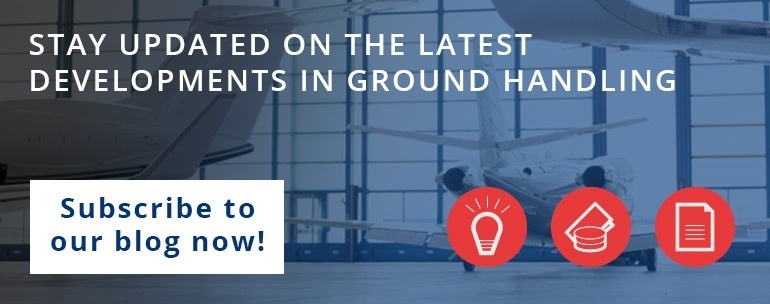Bitcoin. Ethereum. Litecoin. Cryptocurrencies have taken the global economy by storm over the past decade. But they are far from anything to do with aviation, right? Especially support equipment? Well, this is proving to be an altogether incorrect assumption; the technology which powers and secures cryptocurrencies is proving to be very versatile evolving technology for all sorts of ventures. For the sake of aircraft ground support equipment owners, particularly those with a fleet of GSE.
Blockchain is basically Like Excel, Right?
Users with even the most rudimentary skills at the baffling .xls family of files (Excel, Google Sheets, Apple Numbers) can build a simple ledger pretty quickly, and since these are all Cloud-enable now, they can be shared with an unlimited number of team members. Great, right? Yes, for the most part. Except there is one small problem with it: it is not secure in terms of being an untamperable ledger. What this means is that at any time, an individual can go into the file and change figures, numbers, etc..
What exactly does this do for the GSE industry? Well, it might just turn it over on its head. Internal to an agency, it guarantees that when a technician certifies a piece of equipment as serviced, that data will not be altered; the documentation will be locked down as a blockchain link forever.
The added benefit of this is that links of blockchain will be with a given piece of equipment for its entire lifespan. For example, an aircraft tug is produced in a factory. All of the processes and assembly can be documented securely as links in the blockchain. Once the machinery is completely assembled, the quality control inspection is conducted and documented as another link. The purchaser then acquires the manufacturing history of the machine with it and then tracks their own maintenance processes as links in the blockchain. Those who have access to the database have the entire purview of the manufacturing process at their disposal, and each link added to it is an ultra-secure means of building an impenetrable maintenance file.
Blockchain as a Secure, Distributed Database
The original design and framework of blockchain is for digital currencies; it is the technology which allows completely secure transaction between two parties without a third party. We do not always think about the third parties involved in our transactions because we have been subject to them for so long, but they add significant cost and influence into transactions and how we do business. It has been so ingrained in us that the idea of there being any other way to conduct transactions is incomprehensible. Blockchain does just that, though, and a lot more.
Blockchain itself is just that: a block, or link, in a technological shift towards a reliable predictive maintenance shift which is geared to save very significant sums in repairs. Since blockchain is a secure ledger which is insolvent to tampering, maintenance managers are assured that the record is accurate and unaltered since day one. Unlike a cloud document which is a single document accessible by any number of individuals, blockchain is a framework which provides multiple individual documents replicated on separate servers, where any additions to any of the documents is authenticated and updated on the other documents.
Blockchain as a Financial Device
As a financial device, it has the potential to reduce brokerage fees significantly. A brokerage fee can be a percentage, a flat rate, or some sort of hybrid. Their rates are highly variable, but one thing is certain: businesses purchasing high ticket items like airplanes and fleets of GSE would come out much more profitably if they saved even 1%-2% on equipment purchases. When said purchases are measured in millions (or hundreds of millions), that 1% is not nearly so insignificant; it can really help ease the tax burden.
Manufacturers of GSE are also geared to reap dividends in transacting via secure blockchain vice traditional methods of brokerage, since they are generally liable for 50% of brokerage fees. In fact, when you look at it in this light, they may be in an even more advantageous position than the purchaser. Think about it: if they are having to front their portion of brokerage fees on every item sold, on top of all other costs associated with manufacturing and sales, those fees end up in cost overhead and the buyer ultimately is going to eat it. Instead, the manufacturer can do much more useful things with that money saved, like R&D or a lower sticker price.
So, what does this mean in tangible terms?
“Great”, you might be thinking. “Either this technology is too hard to implement or won’t go anywhere”. The bottom line for your business is simple: what can it do for you in tangible, actionable terms?
Harvard Business Review describes blockchain as a foundational technology rather than a disruptive one; a foundational technology being the variety which is slowly integrated over time and has the broad, sweeping potential to completely alter the way we conduct financial and contractual interactions. The adaptation would be very slow over a number of years, but would ultimately restructure the entire framework of banking, brokerage, sales, support, logistics, and infrastructure as a whole. Conversely, disruptive is essentially Amazon: it provides a much cheaper, faster, or otherwise superior solution and flatlines traditional business models and physical businesses.
For you, the business owner, fleet manager, or purchasing agent, blockchain is poised to make your job simpler, faster, and cheaper. But there have been weaknesses exploited in the security infrastructure in way of breaches to cryptocurrencies which use blockchain. But this is going to be the case with any and all emerging technologies as they grow and evolve. Blockchain can be implemented to all equipment of an existing fleet, where historical documentation is uploaded and archived and then a new maintenance ledger is established and maintained.
In very simple terms, blockchain offers a sort of one-stop-shop for storing data, verifying signatures, documentation (both archived and new), and logistics. Fleet managers will really key in on “logistics” because supply chain management is a constant point of contention for maintenance shops and supply hubs alike. Blockchain is poised to upend the virtually impenetrable supply systems by tracking, verifying, and recording all movements of any given item in real time. All movements become new “blocks” in the blockchain, verified by digital signature, again in real time, which creates an utterly transparent audit trail which is basically indisputable by any and all parties in the chain.
An example
A purchasing agent is tasked to order a new piece of GSE, such as a tug, generator, or the like. The serialized piece of machinery has already been “born” into blockchain, with the entire process of manufacture itemized. All components are signed digitally upon assembly by their respective assembler, creating a verifiable ledger. Quality control checks and final assembly inspection are documented here, adding another block in the chain which are time and date stamped. The record continues to build on itself, one block at a time until the item has been completely assembled and is ready for delivery.
But then blockchain can be used as the financial device to actuate the transaction securely without the friction of third party intermediaries (bankers, brokers, attorneys, etc.). Once the transaction is complete, the purchaser now holds access to the manufacturing records and then can record maintenance actions building on the same ledger. This offers tremendous protective measures in regards to warranties and liability protection; maintenance recorded on the ledger is seen in real time by the manufacturer as well as purchaser. If a warranty claim comes up it is much easier to verify if anything has been recorded which will void the warranty.
Farther down the road, the original purchaser decides to sell off the item. The next transaction is again accomplished via blockchain, adding yet another block. This is also a secure means of transferring warranties and verifying whether or not it is still valid since the record is insolvent and fully verified throughout the entire process since day one. The new owner also no longer has to do the typical digging to determine the actual history of the item; it is all laid out right there with the original names and dates, untampered by time. Every step along the way, including the original purchase, is in that series of blocks. This serves everyone well since it forces honesty in the process of property transfer.
Conclusion to blockchain
This article was the FL350 view of blockchain; far from a technical brief. This technology is very promising for basically any and all markets; think about it along the lines of the internet. The internet affects everything we do at one level or another, all day, every day. But only a select few had the imagination and vision to see that, even after it was already being used. Blockchain is in its infancy still and there are so many unanswered questions, but it does have the potential to change the entire logistical landscape of commercial aviation and aviation support.
You want to keep getting updates like these on new trends in aviation and ground handling? Subscribe to our blog now and don’t miss out on new articles!



Comments